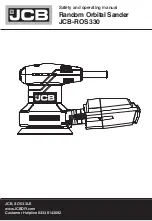
Employers are advised to refer to the HSE publication “Guide for Employers”.
All hand held power tools vibrate to some extent, and this vibration is transmitted to the operator via the
handle, or hand used to steady the tool. Vibration from about 2 to 1500 herz is potentially damaging and is
most hazardous in the range from about 5 to 20 herz.
Operators who are regularly exposed to vibration may suffer from Hand Arm Vibration Syndrome (HAVS),
which includes ‘dead hand’, ‘dead finger’, and ‘white finger’. These are painful conditions and are
widespread in industries where vibrating tools are used.
The health risk depends upon the vibration level and the length of time of exposure to it……in effect, a
daily vibration dose.
Tools are tested using specialised equipment, to approximate the vibration level generated under normal,
acceptable operating conditions for the tool in question. For example, a grinder used at 45° on mild steel
plate, or a sander on softwood in a horizontal plane etc.
These tests produce a value‘a’, expressed in metres per second per second, which represents the average
vibration level of all tests taken, in three axes where necessary, and a second figure ‘K’, which represents
the uncertainty factor, i.e. a value in excess of ‘a’, to which the tool could vibrate under normal conditions.
These values appear in the specification panel below.
You will note that a third value is given in the specification - the highest measured reading in a single
plane. This is the maximum level of vibration measured during testing in one of the axes, and this should
also be taken into account when making a risk assessment.
VIBRATION EMISSIONS
10
‘a’ values in excess of 2.5 m/s
2
are considered hazardous
when used for prolonged periods. A tool with a vibration
value of 2.8 m/s
2
may be used for up to 8 hours
(cumulative) per day, whereas a tool with a value of
11.2 m/s
2
may be used for ½ hour per day only.
The graph opposite shows the vibration value against the
maximum time the respective tool may be used, per day.
The uncertainty factor should also be taken into account when
assessing a risk. The two figures ‘a’ and ‘K’may be added
together and the resulant value used to assess the risk.
It should be noted that if a tool is used under abnormal,
or unusual conditions, then the vibration level could
possibly increase significantly. Users must always take
this into account and make their own risk assessment,
using the graph above as a reference.
Some tools with a high vibration value, such as impact wrenches, are generally used for a few seconds at a
time, therefore the cumulative time may only be in the order of a few minutes per day. Nevertheless, the
cumulative effect, particularly when added to that of other hand held power tools that may be used, must
always be taken into account when the total daily dose rate is determined.
MODEL No:
COS200
DESCRIPTION:
1/3 SHEET ORBITAL SANDER
Declared vibration emmission value in accordance with EN12096
Measured vibration emmission value -
a: .............. 12.755m/s
2
Uncertainty value -
K: ............................................... 1.5m/s
2
Highest measured reading in a single plane ............... 19.635m/s
2
Values determined according to EN28622-2
Summary of Contents for COS200
Page 11: ...11 ...





























